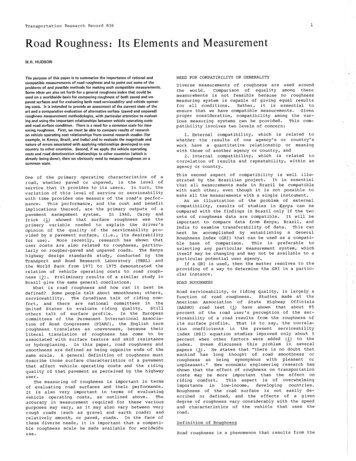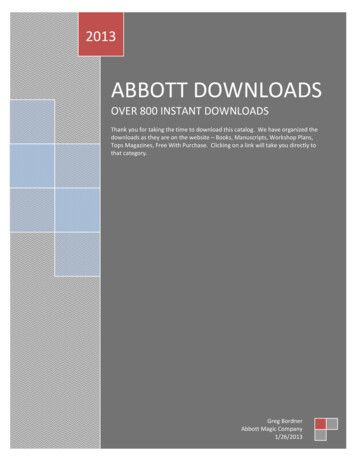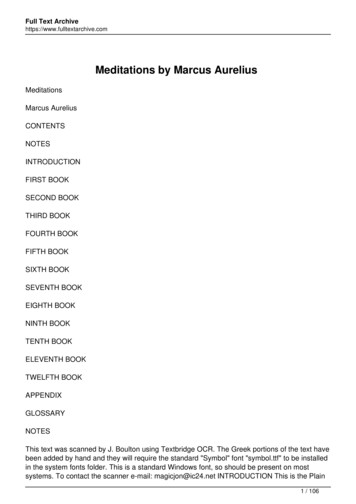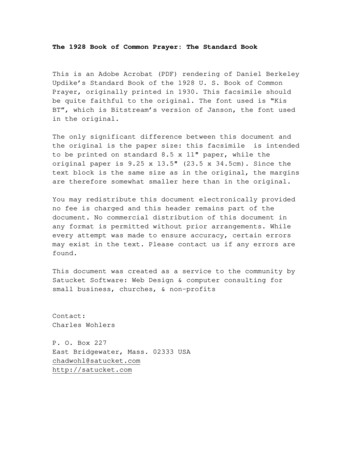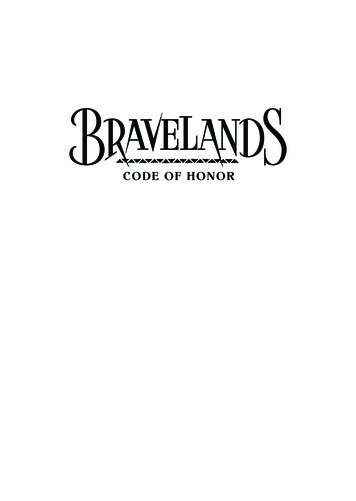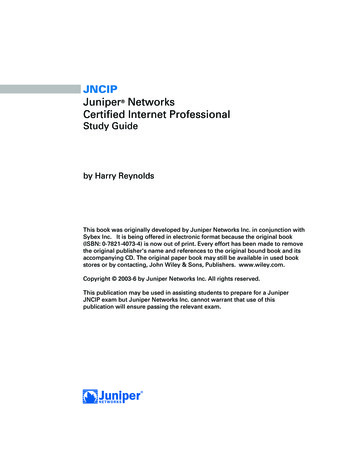
Transcription
JNCIPJuniper NetworksCertified Internet ProfessionalStudy Guideby Harry ReynoldsThis book was originally developed by Juniper Networks Inc. in conjunction withSybex Inc. It is being offered in electronic format because the original book(ISBN: 0-7821-4073-4) is now out of print. Every effort has been made to removethe original publisher's name and references to the original bound book and itsaccompanying CD. The original paper book may still be available in used bookstores or by contacting, John Wiley & Sons, Publishers. www.wiley.com.Copyright 2003-6 by Juniper Networks Inc. All rights reserved.This publication may be used in assisting students to prepare for a JuniperJNCIP exam but Juniper Networks Inc. cannot warrant that use of thispublication will ensure passing the relevant exam.
This book is dedicated to my wife Anita, and to my daughters, Christina and Marissa.Anita, your willingness to “step up” and take in the slack afforded me the time Ineeded to complete this work; this book would not have been possible without youin my life. I thank and commend you all for tolerating the extension cords requiredto power my “pop lab” and for putting up with that pesky circuit breaker that neededresetting every time someone used the hairdryer. Thanks for accommodating me inthis, my labor of love.
AcknowledgmentsThere are numerous people who deserve a round of thanks for assisting with this book. Iwould first like to thank Jason Rogan and Patrick Ames, who got this project started in the firstplace, and in the case of Jason, for providing editorial services to ensure that the certificationprogram was not compromised. I would also like to thank Mae Lum, Linda Stephenson, andMaureen Adams at Sybex for keeping me on schedule and for getting the whole thing rolling.A very big thank-you goes out to the technical editors, Peter Moyer and Josef Buchsteiner. BothPeter and Josef worked very hard to keep me and the resulting book honest.I would also like to thank Juniper Networks and my manager, Scott Edwards, for making thiseffort possible through arrangements that allowed me to access, borrow, or buy the equipmentneeded to build the test bed that formed the basis of this book.—Harry ReynoldsSybex would like to thank electronic publishing specialist Jill Niles and indexer Ted Laux fortheir valuable contributions to this book.
Contents at a GlanceIntroductionxvChapter 1Initial Configuration and Platform Troubleshooting1Chapter 2Interface Configuration and TestingChapter 3OSPF Configuration and Testing153Chapter 4IS-IS Configuration and Testing255Chapter 5IBGP Configuration and Testing373Chapter 6EBGP Configuration and Testing47959Glossary619Index655
ContentsIntroductionChapterChapterxv12Initial Configuration and Platform Troubleshooting1Task 1: Access Routers Using a Terminal ServerConsole ConnectionsTask 2: Configure the OoB Management NetworkTask 3: Create User AccountsConfiguring the Root AccountConfiguring the Lab AccountVerify the Lab AccountConfigure the Ops AccountVerify the Ops AccountTask 4: Configure Syslog ParametersVerify Syslog OperationTask 5: Configure Network Management and NTPConfigure SNMPConfigure NTPTask 6: Perform General Maintenance and Software UpgradeTask 7: Configure Chassis Alarms and RedundancyYour Initial System ConfigurationUsing Cut and PasteSummaryCase Study: Initial System ConfigurationConfiguration RequirementsConfiguration ExamplesThe Completed Case Study ConfigurationSpot the Issues: Review QuestionsSpot the Issues: 5557Interface Configuration and Testing59Loopback InterfacesConfiguring Your lo0 InterfaceVerify Your lo0 Interface ConfigurationPOS InterfacesPhysical Properties for POS InterfacesLogical Properties of POS InterfacesVerifying POS Interface OperationEncapsulation Options for POS InterfacesSummary of POS Interface ConfigurationATM InterfacesPhysical Properties for ATM Interfaces6061616465686971898990
vContentsConfiguring ATM Interface Logical PropertiesVerifying ATM OperationMultipoint ATM ConnectionsATM Traffic ShapingATM Interface SummaryEthernet InterfacesEthernet Interface Physical ConfigurationEthernet Interface Logical PropertiesMAC Address FilteringEthernet Interface SummaryAggregated InterfacesAggregated EthernetAggregated SONETLeaky Bucket Rate LimitingConfigure Leaky Bucket Rate LimitingVerify Leaky Bucket Rate LimitingUnnumbered InterfacesConfigure Unnumbered InterfacesVerify Unnumbered InterfacesSummaryCase Study: Interface ConfigurationCase Study ConfigurationsSpot The Issues: Review QuestionsSpot The Issues: AnswersChapter3OSPF Configuration and TestingMulti-Area Configurationr4 OSPF Configurationr5 OSPF Configurationr3 OSPF ConfigurationArea 1 ConfigurationOSPF Network TypesMultipoint Network TypesNBMA Network TypesTroubleshooting Network Type ProblemsOSPF AuthenticationVerify OSPF AuthenticationStub and Not-So-Stubby AreasStub AreasStub Area DeploymentNot-So-Stubby Areas (NSSA)Address SummarizationConfigure SummarizationVirtual 68172173176179179180188194194198
vviiContentsChapter4OSPF Routing PolicyConfigure OSPF Routing PolicyMetrics and Various Other KnobsSummaryCase Study: OSPFOSPF Case Study AnalysisOSPF Case Study ConfigurationsSpot the Issues: Review QuestionsSpot the Issues: Answers201201222227228230243251254IS-IS Configuration and Testing255Multi-Level IS-IS ConfigurationIS-IS ConfigurationConfigure r5 for IS-IS OperationConfigure r3 for IS-IS OperationArea 49.0002 ConfigurationVerify Overall IS-IS OperationIS-IS Network TypesThe Designated Intermediate SystemIS-IS AuthenticationConfigure Authentication on r5Configure Authentication on r3 and r4Configure Authentication in Area 49.0002Troubleshoot IS-IS AuthenticationIS-IS PolicyRoute Leaking and SummarizationRoute RedistributionMiscellaneous IS-IS KnobsSummaryCase Study: IS-ISIS-IS Case Study AnalysisIS-IS Case Study ConfigurationsSpot the Issues: Review QuestionsSpot the Issues: AnswersChapter5IBGP Configuration and TestingInitial IBGP PeeringIBGP PolicyIBGP AuthenticationConfigure AuthenticationIBGP Route ReflectionConfigure Route ReflectionVerify Route 395
vContentsIBGP ConfederationsConfigure a ConfederationVerify Confederation OperationSave Confederation ConfigurationMiscellaneous IBGP Timers and KnobsIBGP Preference and Load BalancingModify IBGP TimersConfigure Passive ModeUse Local Preference and CommunitiesSummaryCase Study: IGBPIBGP Case Study AnalysisIBGP Case Study ConfigurationsSpot the Issues: Review QuestionsSpot the Issues: 426427429439440442460472476EBGP Configuration and Testing479Initial EBGP PeeringC2 EBGP PeeringC1 EBGP PeeringP1 EBGP PeeringT2 EBGP PeeringT1 EBGP PeeringEBGP and PolicyEBGP Import PolicyEBGP (and IBGP) Export PolicyConfirm Forwarding PathsMiscellaneous EBGP Timers and KnobsAS LoopsInfluence Incoming Traffic FlowSet Local Preference DirectlySummaryCase Study: EBGPEBGP Case Study AnalysisEBGP Case Study ConfigurationsSpot the Issues: Review QuestionsSpot the Issues: 49550554589612617619655
Table of Case StudiesInitial System Configuration42Interface Configuration129OSPF228IS-IS319IGBP440EGBP550
IntroductionGreetings and welcome to the world of Juniper Networks. This introductory section serves asa location to pass on to you some pertinent information concerning the Juniper Networks Technical Certification Program. In addition, you’ll find information about how the book itself islaid out and what it contains. Finally, we’ll review some technical information that you shouldalready know before reading this book.Juniper Networks Technical Certification ProgramThe Juniper Networks Technical Certification Program (JNTCP) consists of two platform-specific,multitiered tracks. Each exam track allows participants to demonstrate their competence withJuniper Networks technology through a combination of written proficiency and hands-on configuration exams. Successful candidates demonstrate a thorough understanding of Internet technologyand Juniper Networks platform configuration and troubleshooting skills.The two JNTCP tracks focus on the M-series Routers & T-series Routing Platforms and theERX Edge Routers, respectively. While some Juniper Networks customers and partners workwith both platform families, it is most common to find individuals working with only one or theother platform. The two different certification tracks allow candidates to pursue specialized certifications, which focus on the platform type most pertinent to their job functions and experience. Candidates wishing to attain a certification on both platform families are welcome to doso, but are required to pass the exams from each track for their desired certification level.This book covers the M-series & T-series track. For information on the ERXEdge Routers certification track, please visit the JNTCP website at http://www.juniper.net/certification.M-series Routers & T-series Routing PlatformsThe M-series Routers certification track consists of four tiers. They include the following:Juniper Networks Certified Internet Associate (JNCIA) The Juniper Networks CertifiedInternet Associate, M-series, T-series Routers (JNCIA-M) certification does not have any prerequisites. It is administered at Prometric testing centers worldwide.Juniper Networks Certified Internet Specialist (JNCIS) The Juniper Networks CertifiedInternet Specialist, M-series, T-series Routers (JNCIS-M) certification also does not have anyprerequisites. Like the JNCIA-M, it is administered at Prometric testing centers worldwide.Juniper Networks Certified Internet Professional (JNCIP) The Juniper Networks CertifiedInternet Professional, M-series, T-series Routers (JNCIP-M) certification requires that candidatesfirst obtain the JNCIS-M certification. The hands-on exam is administered at Juniper Networksoffices in select locations throughout the world.
xiIntroductionJuniper Networks Certified Internet Expert (JNCIE) The Juniper Networks Certified InternetExpert, M-series, T-series Routers (JNCIE-M) certification requires that candidates first obtainthe JNCIP-M certification. The hands-on exam is administered at Juniper Networks offices inselect locations throughout the world.FIGURE I.1JNTCP M-series Routers & T-series Routing Platforms certification trackJNCIAJNCISJNCIPJNCIEJuniper Networks Technical Certification Program (JNTCP)M-series Routers & T-series Routing PlatformsThe JNTCP M-series Routers & T-series Routing Platforms certification trackcovers the M-series and T-series routing platforms as well as the JUNOSsoftware configuration skills required for both platforms. The lab exams areconducted using M-series routers only.Juniper Networks Certified Internet AssociateThe JNCIA-M certification is the first of the four-tiered M-series Routers & T-series RoutingPlatforms track. It is the entry-level certification designed for experienced networking professionals with beginner-to-intermediate knowledge of the Juniper Networks M-series and T-seriesrouters and the JUNOS software. The JNCIA-M (exam code JN0-201) is a computer-based,multiple-choice exam delivered at Prometric testing centers globally for U.S. 125. It is a fastpaced exam that consists of 60 questions to be completed within 60 minutes. The current passing score is set at 70 percent.JNCIA-M exam topics are based on the content of the Introduction to Juniper NetworksRouters, M-series (IJNR-M) instructor-led training course. Just as IJNR-M is the first class moststudents attend when beginning their study of Juniper Networks hardware and software, theJNCIA-M exam should be the first certification exam most candidates attempt. The study topicsfor the JNCIA-M exam include: System operation, configuration, and troubleshooting Routing protocols—BGP, OSPF, IS-IS, and RIP Protocol-independent routing properties Routing policy MPLS Multicast
Introductionxii70 Percent Seems Really Low!The required score to pass an exam can be one indicator of the exam’s difficulty, but not in the waythat many candidates might assume. A lower pass score on an exam does not usually indicate aneasier exam. Ironically, it often indicates the opposite—it’s harder.The JNTCP exams are extensively beta tested and reviewed. The results are then statisticallyanalyzed based on multiple psychometric criteria. Only after this analysis is complete does theexam receive its appropriate passing score. In the case of the JNCIA-M exam, for example,requiring the passing score to be higher than 70 percent would mean that the exam’s targetaudience would have been excluded from passing. In effect, the exam would have been moredifficult to pass. Over time, as more exam statistics are collected, or the exam questions themselves are updated, the passing score may be modified to reflect the exam’s new difficultylevel. The end result is to ensure that the exams are passable by the members of the targetaudience for which they are written.Please be aware that the JNCIA-M certification is not a prerequisite for furthercertification in the M-series Routers & T-series Routing Platforms track. Thepurpose of the JNCIA-M is to validate a candidate’s skill set at the Associatelevel and it is meant to be a stand-alone certification fully recognized and worthyof pride of accomplishment. Additionally, it can be used as a stepping stonebefore attempting the JNCIS-M exam.Juniper Networks Certified Internet SpecialistThe JNCIS-M was originally developed as the exam used to prequalify candidates for admittance to the practical hands-on certification exam. While it still continues to serve this purpose,this certification has quickly become a sought-after designation in its own right. Depending onthe candidates’ job functions, many have chosen JNCIS-M as the highest level of JNTCP certification needed to validate their skill set. Candidates also requiring validation of their hands-onconfiguration and troubleshooting ability on the M-series and T-series routers and the JUNOSsoftware use the JNCIS-M as the required prerequisite to the JNCIP-M practical exam.The JNCIS-M exam tests for a wider and deeper level of knowledge than does the JNCIA-Mexam. Question content is drawn from the documentation set for the M-series routers, the T-seriesrouters, and the JUNOS software. Additionally, on-the-job product experience and an understanding of Internet technologies and design principles are considered to be common knowledgeat the Specialist level.The JNCIS-M (exam code JN0-302) is a computer-based, multiple-choice exam delivered atPrometric testing centers globally for U.S. 125. It consists of 75 questions to be completed in90 minutes. The current passing score is set at 70 percent.
IntroductionxiiiThe study topics for the JNCIS-M exam include: Advanced system operation, configuration, and troubleshooting Routing protocols—BGP, OSPF, and IS-IS Routing policy MPLS Multicast Router and network security Router and network management VPNs IPv6There are no prerequisite certifications for the JNCIS-M exam. While JNCIA-Mcertification is a recommended stepping stone to JNCIS-M certification, candidates are permitted to go straight to the Specialist (JNCIS-M) level.Juniper Networks Certified Internet ProfessionalThe JNCIP-M is the first of the two one-day practical exams in the M-series Routers & T-seriesRouting Platforms track of the JNTCP. The goal of this challenging exam is to validate a candidate’s ability to successfully build an ISP network consisting of seven M-series routers andmultiple EBGP neighbors. Over a period of eight hours, the successful candidate will performsystem configuration on all seven routers, install an IGP, implement a well-designed IBGP,establish connections with all EBGP neighbors as specified, and configure the required routingpolicies correctly.This certification establishes candidates’ practical and theoretical knowledge of core Internettechnologies and their ability to proficiently apply that knowledge in a hands-on environment.This exam is expected to meet the hands-on certification needs of the majority of Juniper Networkscustomers and partners. The more advanced JNCIE-M exam focuses on a set of specialized skillsand addresses a much smaller group of candidates. You should carefully consider your certificationgoals and requirements, for you may find that the JNCIP-M exam is the highest-level certification you need.The JNCIP-M (exam code CERT-JNCIP-M) is delivered at one of several Juniper Networksoffices worldwide for U.S. 1,250. The current passing score is set at 80 percent.The study topics for the JNCIP-M exam include: Advanced system operation, configuration, and troubleshooting Routing protocols—BGP, OSPF, IS-IS, and RIP Routing policy Routing protocol redistribution VLANs VRRP
IntroductionxivThe JNCIP-M certification is a prerequisite for attempting the JNCIE-Mpractical exam.Juniper Networks Certified Internet ExpertAt the pinnacle of the M-series Routers & T-series Routing Platforms track is the one-day JNCIE-Mpractical exam. The E stands for Expert and they mean it—the exam is the most challenging andrespected of its type in the industry. Maintaining the standard of excellence established over twoyears ago, the JNCIE-M certification continues to give candidates the opportunity to distinguishthemselves as the truly elite of the networking world. Only a few have dared attempt this exam,and fewer still have passed.The new eight-hour format of the exam requires that candidates troubleshoot an existing andpreconfigured ISP network consisting of 10 M-series routers. Candidates are then presented withadditional configuration tasks appropriate for an expert-level engineer.The JNCIE-M (exam code CERT-JNCIE-M) is delivered at one of several Juniper Networksoffices worldwide for U.S. 1,250. The current passing score is set at 80 percent.The study topics for the JNCIE-M exam may include: Expert-level system operation, configuration, and troubleshooting Routing protocols—BGP, OSPF, IS-IS, and RIP Routing protocol redistribution Advanced routing policy implementation Firewall filters Class of service MPLS VPNs IPv6 IPSec MulticastSince the JNCIP-M certification is a prerequisite for attempting this practicalexam, all candidates who pass the JNCIE-M will have successfully completedtwo days of intensive practical examination.Registration ProceduresJNTCP written exams are delivered worldwide at Prometric testing centers. To register, visitPrometric’s website at http://www.2test.com (or call 1-888-249-2567 in North America) toopen an account and register for an exam.
xvIntroductionThe JNTCP Prometric exam numbers are: JNCIA-M—JN0-201 JNCIS-M—JN0-302JNTCP lab exams are delivered by Juniper Networks at select locations. Currently the testinglocations are: Sunnyvale, CA Herndon, VA Amsterdam, HollandOther global locations are periodically set up as testing centers based on demand. To register,send an e-mail message to Juniper Networks at certification-testreg@juniper.net andplace one of the following exam codes in the subject field. Within the body of the message, indicate the testing center you prefer and which month you would like to attempt the exam. Youwill be contacted with the available dates at your requested testing center. The JNTCP lab examnumbers are: JNCIP-M—CERT-JNCIP-M JNCIE-M—CERT-JNCIE-MRecertification RequirementsTo maintain the high standards of the JNTCP certifications, and to ensure that the skills of thosecertified are kept current and relevant, Juniper Networks has implemented the following recertification requirements, which apply to both certification tracks of the JNTCP: All JNTCP certifications are valid for a period of two years. Certification holders who do not renew their certification within this two-year period willhave their certification placed in suspended mode. Certifications in suspended mode are noteligible as prerequisites for further certification and cannot be applied to partner certification requirements. After being in suspended mode for one year, the certification is placed in inactive mode. Atthat stage, the individual is no longer certified at the JNTCP certification level that hasbecome inactive and the individual will lose the associated certification number. For example,a JNCIP holder placed in inactive mode will be required to pass both the JNCIS and JNCIPexams in order to regain JNCIP status; such an individual will be given a new JNCIPcertification number. Renewed certifications are valid for a period of two years from the date of passing therenewed certification exam. Passing an exam at a higher level renews all lower-level certifications for two years from thedate of passing the higher-level exam. For example, passing the JNCIP exam will renew theJNCIS certification (and JNCIA certification if currently held) for two years from the dateof passing the JNCIP exam.
Introductionxvi JNCIA holders must pass the current JNCIA exam in order to renew the certification foran additional two years from the most recent JNCIA pass date. JNCIS holders must pass the current JNCIS exam in order to renew the certification for anadditional two years from the most recent JNCIS pass date. JNCIP and JNCIE holders must pass the current JNCIS exam in order to renew these certifications for an additional two years from the most recent JNCIS pass date.The most recent version of the JNTCP Online Agreement must be accepted forthe recertification to become effective.JNTCP Nondisclosure AgreementJuniper Networks considers all written and practical JNTCP exam material to be confidentialintellectual property. As such, an individual is not permitted to take home, copy, or re-create theentire exam or any portions thereof. It is expected that candidates who participate in the JNTCPwill not reveal the detailed content of the exams.For written exams delivered at Prometric testing centers, candidates must accept the onlineagreement before proceeding with the exam. When taking practical exams, candidates are provided with a hard-copy agreement to read and sign before attempting the exam. In either case,the agreement can be downloaded from the JNTCP website for your review prior to the testingdate. Juniper Networks retains all signed hard-copy nondisclosure agreements on file.Candidates must accept the online JNTCP Online Agreement in order for theircertifications to become effective and to have a certification number assigned.You can do this by going to the CertManager site at http://www.certmanager.net/juniper.Resources for JNTCP ParticipantsReading this book is a fantastic place to begin preparing for your next JNTCP exam. Youshould supplement the study of this volume’s content with related information from varioussources. The following resources are available for free and are recommended to anyone seekingto attain or maintain Juniper Networks certified status.JNTCP WebsiteThe JNTCP website (http://www.juniper.net/certification) is the place to go for the mostup-to-date information about the program. As the program evolves, this website is periodicallyupdated with the latest news and major announcements. Possible changes include new exams andcertifications, modifications to the existing certification and recertification requirements, andinformation about new resources and exam objectives.
xviiIntroductionThe site consists of separate sections for each of the certification tracks. The informationyou’ll find there includes the exam number, passing scores, exam time limits, and exam topics.A special section dedicated to resources is also provided to supply you with detailed exam topicoutlines, sample written exams, and study guides. The additional resources listed next are alsolinked from the JNTCP website.CertManagerThe CertManager system (http://www.certmanager.net/juniper) provides you with a placeto track your certification progress. The site requires a username and password for access, and youtypically use the information contained on your hard-copy score report from Prometric the firsttime you log in. Alternatively, a valid login can be obtained by sending an e-mail message tocertification@juniper.net with the word certmanager in the subject field.Once you log in, you can view a report of all your attempted exams. This report includes theexam dates, your scores, and a progress report indicating the additional steps required to attaina given certification or recertification. This website is where you accept the online JNTCP agreement, which is a required step to become certified at any level in the program. You can also usethe website to request the JNTCP official certification logos to use on your business cards,resumes, and websites.Perhaps most important, the CertManager website is where all your contact information iskept up-to-date. Juniper Networks uses this information to send you certification benefits, suchas your certificate of completion, and to inform you of important developments regarding yourcertification status. A valid company name is used to verify a partner’s compliance with certification requirements. To avoid missing out on important benefits and information, you shouldensure your contact information is kept current.Juniper Networks Training CoursesJuniper Networks training courses (http://www.juniper.net/training) are the best sourceof knowledge for seeking a certification and to increase your hands-on proficiency with JuniperNetworks equipment and technologies. While attendance of official Juniper Networks trainingcourses doesn’t guarantee a passing score on the certification exam, it does increase the likelihood of your successfully passing it. This is especially true when you seek to attain JNCIP orJNCIE status, where hands-on experience is a vital aspect of your study plan.Juniper Networks Technical DocumentationYou should be intimately familiar with the Juniper Networks technical documentation set(http://www.juniper.net/techpubs). During the JNTCP lab exams (JNCIP and JNCIE),these documents are provided in PDF on your PC. Knowing the content, organizational structure, and search capabilities of these manuals is a key component for a successful exam attempt.At the time of this writing, hard-copy versions of the manuals are provided only for the handson lab exams. All written exams delivered at Prometric testing centers are closed-book exams.
IntroductionxviiiJuniper Networks Solutions and TechnologyTo broaden and deepen your knowledge of Juniper Networks products and their applications,you can visit http:///www.juniper.net/techcenter. This website contains white papers,application notes, frequently asked questions (FAQ), and other informative documents, such ascustomer profiles and independent test results.Group StudyThe Groupstudy mailing list and website (http://www.groupstudy.com/list/juniper.html)is dedicated to the discussion of Juniper Networks products and technologies for the purposeof preparing for certification testing. You can post and receive answers to your own technicalquestions or simply read the questions and answers of other list members.Tips for Taking Your ExamTime, or the lack thereof, is normally one of the biggest factors influencing the outcome ofJNCIP-M certification attempts. Having to single-handedly configure numerous protocols andparameters on seven routers while in a somewhat stressful environment often serves as a rudewake-up call early in the JNCIP-M candidate’s first attempt.Although the product documentation is provided during the exam, you will likely run short ontime if you have to refer to it more than once or twice during your exam. The successful candidatewill have significant practice time with the JUNOS software CLI, and will be experienced withvirtually all aspects of protocol configuration, so that commands can be entered quickly andaccurately without the need for user manuals.Although troubleshooting is not a specific component of the exam, many candidates may spenda good portion of their time fault-isolating issues that result from their own configuration mistakes or that result from unanticipated interactions between the various protocols involved.Being able to quickly assess the state of the network, and to rapidly isolate and correct mistakesand omissions, are critical skills that a successful JNCIP candidate must possess.The JNCIP-M exam is scored in a non-linear fashion—this means that a candidate can losepoints for a single mistake that happens to affect multiple aspects of their network. The goal ofthis grading approach can be summed up as “We grade on results, as opposed to individualconfiguration statements, and your grade will be determined by the overall operational state ofyour network at the end of the exam.” This is a significant point, and one that needs some elaboration, because many candidates are surprised to see how many points can be lost due to asingle mistake on a critical facet of the exam.
xixIntroductionNon-linear grading The JNCIP-M exam is made up of several sections, and each section isworth a number of points. Missing too many of the criteria within one section can result in zeropoints being awarded for the entire section, even if the candidate configured some aspects ofthe task correctly! Getting zero points on a section almost always results in an insufficient number of total points for a passing grade. The goal of this grading approach is to ensure that theJNCIP candidate is able to at least get the majority of each task right. Put another way, “Howcan you be deemed a Professional if you cannot get a significant portion of your OSPF or IS-ISconfiguration correct?”Results-based grading Because of the numerous ways that JUNOS s
Juniper Networks Technical Certification Program The Juniper Networks Technical Certification Program (JNTCP) consists of two platform-specific, multitiered tracks. Each exam track allows participants to demonstrate their competence with Juniper Networks technology through a combination of written proficiency and hands-on configu-ration exams.
